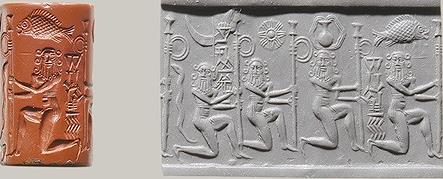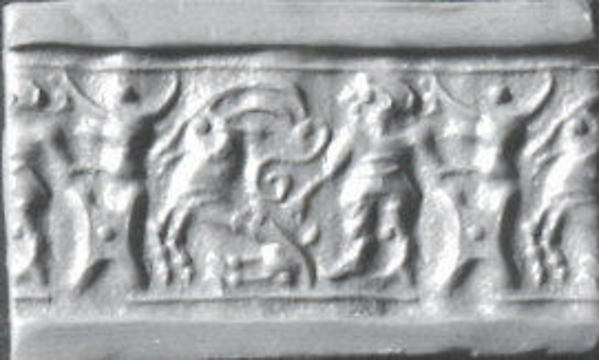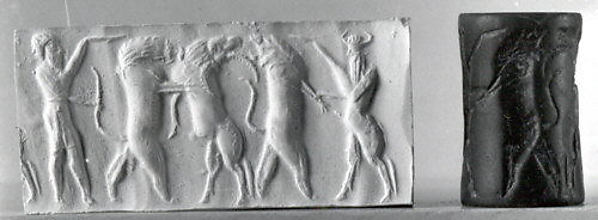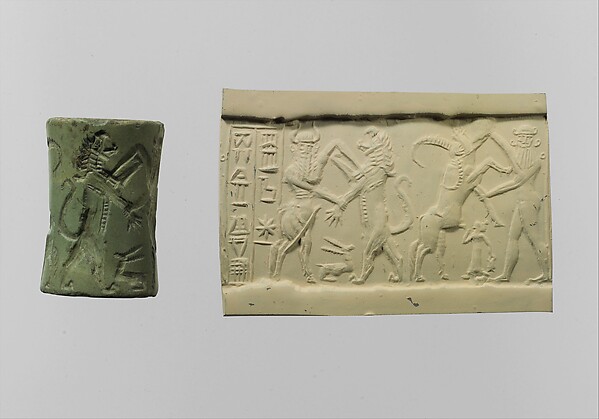Mirror: http://tinyurl.com/pd4og6p
A few Ancient Near East cylinder seals of Metropolitan Museum are presented in this note identifying Indus Script hieroglyphs used on the artefacts.
Many recurring hieroglyphs are read rebus in Prakritam of Indus Script cipher as metalwork catalogues:
Narratives of encounters depicted on cylinder seals are some times described by art historians as 'combat scenes' or 'introduction scenes'. It is possible that they are also metals trade transaction narratives, deciphering the pictorial motifs as Indus Script hieroglyph multiplexes or hypertexts of cipher messages in Prakritam (Meluhha, mleccha).
sũb 'cord, string' Rebus: शुल्वम् śulvam (ल्बम् lbam) 'copper'
ariye 'lion' Rebus: ara 'brass' as in ArakUTa (Samskritam)
barad 'bull' Rebus: bharat 'alloy of copper, pewter, tin'
kuThAru 'monkey' Rebus: kuThAru 'armourer'
kuThari 'crucible' Rebus: kuThari 'storekeeper, treasury'
arka 'sun' Rebus: arka, eraka 'copper, moltencast, gold'
ranku 'antelope' Rebus: ranku 'tin'
garuDa 'eagle' kAraNDava 'aquatic bird' karaDi 'safflower' Rebus: karaDa 'hard alloy'
baTa 'quail' Rebus: bhaTa 'furnace'
meDha 'polar star' Rebus: meD 'iron'
bicha 'scorpion' Rebus: bica 'hematite ore'
DAng 'mountain range' Rebus: dhangar 'blacksmith'
rango 'buffalo' Rebus: rango 'pewter'
muh 'face' Rebus: mUhA 'ingot'
mlekh 'goat' Rebus: milakkhu, mleccha 'copper, Meluhha'
Hieroglyph: small ball: *gōṭṭa ʻ something round ʼ. [Cf.guḍá -- 1 . -- In sense ʻ fruit, kernel ʼ cert. ← Drav., cf. Tam. koṭṭai ʻ nut, kernel ʼ, Kan. goṟaṭe &c. listed DED 1722]K. goṭh f., dat. °ṭi f. ʻ chequer or chess or dice board ʼ; S. g̠oṭu m. ʻ large ball of tobacco ready for hookah ʼ, °ṭī f. ʻ small do. ʼ; P. goṭ f. ʻ spool on which gold or silver wire is wound, piece on a chequer board ʼ; N. goṭo ʻ piece ʼ, goṭi ʻ chess piece ʼ; A. goṭ ʻ a fruit, whole piece ʼ, °ṭā ʻ globular, solid ʼ, guṭi ʻ small ball, seed, kernel ʼ; B. goṭā ʻ seed, bean, whole ʼ; Or. goṭā ʻ whole, undivided ʼ, goṭi ʻ small ball, cocoon ʼ, goṭāli ʻ small round piece of chalk ʼ; Bi. goṭā ʻ seed ʼ; Mth. goṭa ʻ numerative particle ʼ; H. goṭ f. ʻ piece (at chess &c.) ʼ; G. goṭ m. ʻ cloud of smoke ʼ, °ṭɔ m. ʻ kernel of coconut, nosegay ʼ, °ṭī f. ʻ lump of silver, clot of blood ʼ, °ṭilɔ m. ʻ hard ball of cloth ʼ; M. goṭā m. ʻ roundish stone ʼ, °ṭī f. ʻ a marble ʼ, goṭuḷā ʻ spherical ʼ; Si. guṭiya ʻ lump, ball ʼ; -- prob. also P. goṭṭā ʻ gold or silver lace ʼ, H. goṭā m. ʻ edging of such ʼ (→ K. goṭa m. ʻ edging of gold braid ʼ, S. goṭo m. ʻ gold or silver lace ʼ); M. goṭ ʻ hem of a garment, metal wristlet ʼ.Addenda: *gōṭṭa -- : also Ko. gōṭu ʻ silver or gold braid ʼ.(CDIAL 4271)
Rebus: gota (laterite)
See: http://bharatkalyan97.blogspot.in/2015/08/ancient-near-east-jasper-cylinder-seal.html
![]()
Red jasper H. 1 1/8 in. (2.8 cm), Diam. 5/8 in. (1.6 cm) cylinder Seal with four hieroglyphs and four kneeling persons (with six curls on their hair) holding flagposts, c. 2220-2159 B.C.E., Akkadian (Metropolitan Museum of Art) Cylinder Seal (with modern impression). The four hieroglyphs are: from l. to r. 1. crucible PLUS storage pot of ingots, 2. sun, 3. narrow-necked pot with overflowing water, 4. fish A hooded snake is on the edge of the composition. (The dark red color of jasper reinforces the semantics: eruvai 'dark red, copper' Hieroglyph: eruvai 'reed'; see four reedposts
The four posts held on this jasper cylinder seal compares with similar posts shown on some other cylinder seals. They may signify: पेंढें ‘rings’ Rebus: पेढी ‘shop’.
Hieroglyph: cord: śúlba -- , śulva -- n. ʻ string, cord ʼ ŚrS.Pk. suvva -- n. ʻ cord ʼ; L. sub, (Ju.) suḇ m. ʻ band on a sheaf of corn ʼ; P. subb, chubb m. ʻ band on a sheaf of corn, twist of tobacco, swab to clean utensils ʼ, subbā, chu° m. ʻ band of twisted straw, bandage ʼ, subbaṛ m. ʻ id. ʼ, subbī, chu° f. ʻ small do. ʼ; M. sũb, sũbh n. m. ʻ fibrous integuments of coconut ʼ. (CDIAL 12544) शुल्व [p= 1084,2](or शुल्ब) n. (accord. to some also m. and अ or f(ई).) a string , cord , rope S3rS. Su1ryas.BhP.
Rebus: copper: शुल्व [p= 1084,2]N. of a परिशिष्ट Cat. L. also " copper "
शुल्लम् 1 A cord, rope, string. -2 Copper. शुल्वम् śulvam (ल्बम् lbam)
शुल्वम् (ल्बम्) [शुल्ब्-अच्] 1 A rope, string; ततो मन्त्रबलाच्छुल्बे तक्षके वज्रिणः करात् Bm.1.194; शुल्वं सुतस्य न तु तत्तदमुष्य माति Bhāg.2.7.3. -2 Copper. -3 A sacrificial rite or act. -4 The proximity of water, a place near it. -5 A rule, law, an institute. -ल्वा, -ल्वी See above. -Comp. -अरिः sulphur. -जम् brass. -सूत्रम्N. of Sūtra work, containing mathematical calculations required for श्रौत rituals.(Samskritam. Apte)
Plofker, Kim (2007).
![Cylinder seal]()
![Cylinder seal]()
![Cylinder seal and modern impression: male and griffin demon slaying animal; terminal: animal attack scenes, guilloche]()
![Cylinder seal and modern impression: royal figures approaching weather god; divinities]()
![Cylinder seal]()
![Cylinder seal]()
![Cylinder seal]()
![Cylinder seal]()
![Cylinder seal and modern impression: seated goddess before figures carrying boxes, one placed on "altar"]()
![Cylinder seal]()
![Cylinder seal]()
![]()
![]() Old Babylonian Cylinder Seal, hematite. c. 1800 BCE. The king makes an animal offering to Shamash. The style of this seal suggests that it originated from a workshop in SipparAl-Gailani Werr, L., 1988. Studies in the chronology and regional style of Old Babylonian Cylinder Seals. Bibliotheca Mesopotamica, Volume 23.
Old Babylonian Cylinder Seal, hematite. c. 1800 BCE. The king makes an animal offering to Shamash. The style of this seal suggests that it originated from a workshop in SipparAl-Gailani Werr, L., 1988. Studies in the chronology and regional style of Old Babylonian Cylinder Seals. Bibliotheca Mesopotamica, Volume 23.
![]() Old Babylonian cylinder seal, c.1800 BCE, hematite. Linescan camera image of seal above (reversed to resemble an impression).
Old Babylonian cylinder seal, c.1800 BCE, hematite. Linescan camera image of seal above (reversed to resemble an impression).
![]()
Mesopotamian limestone cylinder seal and impression—worship of Shamash, (Louvre)
![Cylinder seal: worshiper and the sun god; king; bull-man and a lion-man]()
![Cylinder seal]()
![Cylinder seal and modern impression: smiting weather god before king and goddess]()
![Cylinder seal: man grasping an antelope, bull's head over ingot]()
![Cylinder seal]()
![Cylinder seal and modern impression: bull-man combatting lion; nude hero combatting water buffalo; inscription]()
A few Ancient Near East cylinder seals of Metropolitan Museum are presented in this note identifying Indus Script hieroglyphs used on the artefacts.
Many recurring hieroglyphs are read rebus in Prakritam of Indus Script cipher as metalwork catalogues:
Narratives of encounters depicted on cylinder seals are some times described by art historians as 'combat scenes' or 'introduction scenes'. It is possible that they are also metals trade transaction narratives, deciphering the pictorial motifs as Indus Script hieroglyph multiplexes or hypertexts of cipher messages in Prakritam (Meluhha, mleccha).
sũb 'cord, string' Rebus: शुल्वम् śulvam (ल्बम् lbam) 'copper'
ariye 'lion' Rebus: ara 'brass' as in ArakUTa (Samskritam)
barad 'bull' Rebus: bharat 'alloy of copper, pewter, tin'
kuThAru 'monkey' Rebus: kuThAru 'armourer'
kuThari 'crucible' Rebus: kuThari 'storekeeper, treasury'
arka 'sun' Rebus: arka, eraka 'copper, moltencast, gold'
ranku 'antelope' Rebus: ranku 'tin'
garuDa 'eagle' kAraNDava 'aquatic bird' karaDi 'safflower' Rebus: karaDa 'hard alloy'
baTa 'quail' Rebus: bhaTa 'furnace'
meDha 'polar star' Rebus: meD 'iron'
bicha 'scorpion' Rebus: bica 'hematite ore'
DAng 'mountain range' Rebus: dhangar 'blacksmith'
rango 'buffalo' Rebus: rango 'pewter'
muh 'face' Rebus: mUhA 'ingot'
mlekh 'goat' Rebus: milakkhu, mleccha 'copper, Meluhha'
lokaNTam ‘overflowing pot’ Rebus: lokhanda ‘metal implements’
Hieroglyph: small ball: *gōṭṭa ʻ something round ʼ. [Cf.
Rebus: gota (laterite)
See: http://bharatkalyan97.blogspot.in/2015/08/ancient-near-east-jasper-cylinder-seal.html

Red jasper H. 1 1/8 in. (2.8 cm), Diam. 5/8 in. (1.6 cm) cylinder Seal with four hieroglyphs and four kneeling persons (with six curls on their hair) holding flagposts, c. 2220-2159 B.C.E., Akkadian (Metropolitan Museum of Art) Cylinder Seal (with modern impression). The four hieroglyphs are: from l. to r. 1. crucible PLUS storage pot of ingots, 2. sun, 3. narrow-necked pot with overflowing water, 4. fish A hooded snake is on the edge of the composition. (The dark red color of jasper reinforces the semantics: eruvai 'dark red, copper' Hieroglyph: eruvai 'reed'; see four reedposts
The four posts held on this jasper cylinder seal compares with similar posts shown on some other cylinder seals. They may signify: पेंढें ‘rings’ Rebus: पेढी ‘shop’.
Hieroglyph: cord: śúlba -- , śulva -- n. ʻ string, cord ʼ ŚrS.Pk. suvva -- n. ʻ cord ʼ; L. sub, (Ju.) suḇ m. ʻ band on a sheaf of corn ʼ; P. subb, chubb m. ʻ band on a sheaf of corn, twist of tobacco, swab to clean utensils ʼ, subbā, chu° m. ʻ band of twisted straw, bandage ʼ, subbaṛ m. ʻ id. ʼ, subbī, chu° f. ʻ small do. ʼ; M. sũb, sũbh n. m. ʻ fibrous integuments of coconut ʼ. (CDIAL 12544) शुल्व [p= 1084,2](or शुल्ब) n. (accord. to some also m. and अ or f(ई).) a string , cord , rope S3rS. Su1ryas.BhP.
Rebus: copper: शुल्व [p= 1084,2]N. of a परिशिष्ट Cat. L. also " copper "
शुल्लम् 1 A cord, rope, string. -2 Copper. शुल्वम् śulvam (ल्बम् lbam)
शुल्वम् (ल्बम्) [शुल्ब्-अच्] 1 A rope, string; ततो मन्त्रबलाच्छुल्बे तक्षके वज्रिणः करात् Bm.1.194; शुल्वं सुतस्य न तु तत्तदमुष्य माति Bhāg.2.7.3. -2 Copper. -3 A sacrificial rite or act. -4 The proximity of water, a place near it. -5 A rule, law, an institute. -ल्वा, -ल्वी See above. -Comp. -अरिः sulphur. -जम् brass. -सूत्रम्N. of Sūtra work, containing mathematical calculations required for श्रौत rituals.(Samskritam. Apte)
Plofker, Kim (2007).
Certain shapes and sizes of fire-altars were associated with particular gifts that the sacrificer desired from the gods: "he who desires heaven is to construct a fire-altar in the form of a falcon"; "a fire-altar in the form of a tortoise is to be constructed by one desiring to win the world of Brahman"; "those who wish to destroy existing and future enemies should construct a fire-altar in the form of a rhombus" [Sen and Bag 1983, 86, 98, 111].(Plofker, Kim (2007). "Mathematics in India". The Mathematics of Egypt, Mesopotamia, China, India, and Islam: A Sourcebook. Princeton University Press.) Baudhāyana Śulbasûtra is dated o c. 800 BCE with rules of Geometry for shapes of fire-altars:
दीर्घचतुरश्रस्याक्ष्णया रज्जु: पार्श्र्वमानी तिर्यग् मानी च यत् पृथग् भूते कुरूतस्तदुभयं करोति ॥
dīrghasyākṣaṇayā rajjuḥ pārśvamānī, tiryaḍam mānī,
cha yatpṛthagbhūte kurutastadubhayāṅ karoti.
dīrghasyākṣaṇayā rajjuḥ pārśvamānī, tiryaḍam mānī,
cha yatpṛthagbhūte kurutastadubhayāṅ karoti.
- A rope stretched along the length of the diagonal produces an area which the vertical and horizontal sides make together. See: Kak, S. and Prabhu, M. Cryptographic applications of primitive Pythagorean triples. Cryptologia, 38:215-222, 2014.

Period: Old Syrian
Date: ca. 1820–1730 B.C.
Geography: Syria
Medium: Hematite
Dimensions: H. 1 1/16 in. (2.7 cm); Diam. 1/2 in. (1.2 cm)
Classification: Stone-Cylinder Seals
Credit Line: Gift of Nanette B. Kelekian, in memory of Charles Dikran and Beatrice Kelekian, 1999
Accession Number: 1999.325.142 Metmuseum

Period: Old Syrian
Date: ca. 1720–1650 B.C.
Geography: Syria
Medium: Hematite
Dimensions: H. 15/16 in. (2.4 cm); Diam. 3/8 in. (1 cm)
Classification: Stone-Cylinder Seals
Credit Line: Gift of Nanette B. Kelekian, in memory of Charles Dikran and Beatrice Kelekian, 1999
Accession Number: 1999.325.155 Metmuseum

Cylinder seal and modern impression: male and griffin demon slaying animal; terminal: animal attack scenes, guilloche
Period: Mitanni
Date: 2nd millennium B.C.
Geography: Mesopotamia or Syria
Culture: Mitanni
Medium: Hematite
Dimensions: H. 13/16 in. (2 cm); Diam. 7/16 in. (1.1 cm)
Classification: Stone-Cylinder Seals
Credit Line: Gift of Nanette B. Kelekian, in memory of Charles Dikran and Beatrice Kelekian, 1999
Accession Number: 1999.325.165 Metmuseum

Cylinder seal and modern impression: royal figures approaching weather god; divinities
Period: Old Syrian
Date: ca. 1720–1650 B.C.
Geography: Syria
Medium: Hematite
Dimensions: H, 1 1/8 in. (2.9 cm); Diam. 7/16 in. (1.1 cm)
Classification: Stone-Cylinder Seals
Credit Line: Gift of Nanette B. Kelekian, in memory of Charles Dikran and Beatrice Kelekian, 1999
Accession Number: 1999.325.147 Metmuseum

Cylinder seal
Period: Mitanni
Date: ca. late 2nd millennium B.C.
Geography: Mesopotamia or Syria
Culture: Mitanni
Medium: Hematite
Dimensions: H. 1 in. (2.6 cm); Diam. 1/2 in. (1.2 cm)
Classification: Stone-Cylinder Seals
Credit Line: Gift of Nanette B. Kelekian, in memory of Charles Dikran and Beatrice Kelekian, 1999
Accession Number: 1999.325.190 Metmuseum

Period: Old Syrian
Date: ca. 1720–1650 B.C.
Geography: Syria
Medium: Stone
Dimensions: H. 1.9 cm x Diam. 1.1 cm
Classification: Stone-Cylinder Seals
Credit Line: Bequest of W. Gedney Beatty, 1941
Accession Number: 41.160.189 Metmuseum
Period: Old Syrian
Date: ca. 1820–1730 B.C.
Geography: Syria
Medium: Hematite
Dimensions: H. 13/16 in. (2 cm); Diam. 5/16 in. (0.8 cm)
Classification: Stone-Cylinder Seals
Credit Line: Gift of Nanette B. Kelekian, in memory of Charles Dikran and Beatrice Kelekian, 1999
Accession Number: 1999.325.177 Metmuseum

Period: Old Babylonian
Date: ca. 19th–16th century B.C.
Geography: Mesopotamia
Culture: Babylonian
Medium: Limonite
Dimensions: 0.89 in. (2.26 cm)
Classification: Stone-Cylinder Seals
Credit Line: Bequest of W. Gedney Beatty, 1941
Accession Number: 41.160.321 Metmuseum

Period: Old Babylonian
Date: ca. early 2nd millennium B.C.
Geography: Mesopotamia
Culture: Babylonian
Medium: Hematite
Dimensions: H. 13/16 in. (2.0 cm); Diam. 7/16 in. (1.1 cm)
Classification: Stone-Cylinder Seals
Credit Line: Gift of Nanette B. Kelekian, in memory of Charles Dikran and Beatrice Kelekian, 1999
Accession Number: 1999.325.14 Metmuseum

Cylinder seal and modern impression: seated goddess before figures carrying boxes, one placed on "altar"
Period: Early Dynastic IIIa
Date: ca. 2600–2500 B.C.
Geography: Mesopotamia
Culture: Sumerian
Medium: Marble
Dimensions: 0.93 in. (2.36 cm)
Classification: Stone-Cylinder Seals
Credit Line: Gift of Martin and Sarah Cherkasky, 1984
Accession Number: 1984.383.5 Metmuseum

Period: Old Syrian
Date: ca. early 2nd millennium B.C.
Geography: Syria
Medium: Hematite
Dimensions: H. 11/16 in. (1.7 cm); Diam. 5/16 in. (0.8 cm)
Classification: Stone-Cylinder Seals
Credit Line: Gift of Nanette B. Kelekian, in memory of Charles Dikran and Beatrice Kelekian, 1999
Accession Number: 1999.325.161 Metmuseum

< 6 of 843 search results>
Cylinder seal
Period: Old Syrian
Date: ca. 1820–1730 B.C.
Geography: Syria
Medium: Hematite
Dimensions: H. 3/4 in. (1.9 cm); Diam. 7/16 in. (1.1 cm)
Classification: Stone-Cylinder Seals
Credit Line: Gift of Nanette B. Kelekian, in memory of Charles Dikran and Beatrice Kelekian, 1999
Accession Number: 1999.325.157 Metmuseum

 Old Babylonian Cylinder Seal, hematite. c. 1800 BCE. The king makes an animal offering to Shamash. The style of this seal suggests that it originated from a workshop in SipparAl-Gailani Werr, L., 1988. Studies in the chronology and regional style of Old Babylonian Cylinder Seals. Bibliotheca Mesopotamica, Volume 23.
Old Babylonian Cylinder Seal, hematite. c. 1800 BCE. The king makes an animal offering to Shamash. The style of this seal suggests that it originated from a workshop in SipparAl-Gailani Werr, L., 1988. Studies in the chronology and regional style of Old Babylonian Cylinder Seals. Bibliotheca Mesopotamica, Volume 23. Old Babylonian cylinder seal, c.1800 BCE, hematite. Linescan camera image of seal above (reversed to resemble an impression).
Old Babylonian cylinder seal, c.1800 BCE, hematite. Linescan camera image of seal above (reversed to resemble an impression).
Mesopotamian limestone cylinder seal and impression—worship of Shamash, (Louvre)

Cylinder seal: worshiper and the sun god; king; bull-man and a lion-man
Period: Old Babylonian
Date: ca. 18th century B.C.
Geography: Mesopotamia or Syria
Culture: Babylonian
Medium: Hematite
Dimensions: 0.94 x 0.47 in. (2.39 x 1.19 cm)
Classification: Stone-Cylinder Seals
Credit Line: Purchase, Raymond and Beverly Sackler Gift, 1991
Accession Number: 1991.368.1 Metmuseum.
References:
Eisen, Gustavus A. 1940. Ancient Oriental Cylinder and other Seals with a Description of the Collection of Mrs. William H. Moore. Oriental Institute Publications 42. Chicago: The University of Chicago Press, no. 59, pp. 48-49, pl. VII.
Williams- Forte, Elizabeth. 1976. A Selection of Stamp and Cylinder Seals from the Collection of Mrs. William H. Moore. New York: Metropolitan Museum of Art, no. 20.
Sotheby's. The Ada Small Moore Collection of Ancient Near Eastern Seals. 12 December 1991, New York, lot 57.
Aruz, Joan. 1992. "Ancient World." The Metropolitan Museum of Art Bulletin 50 (2), Recent Acquisitions: A Selection 1991-1992 (Autumn, 1992), p. 6.
Williams- Forte, Elizabeth. 1976. A Selection of Stamp and Cylinder Seals from the Collection of Mrs. William H. Moore. New York: Metropolitan Museum of Art, no. 20.
Sotheby's. The Ada Small Moore Collection of Ancient Near Eastern Seals. 12 December 1991, New York, lot 57.
Aruz, Joan. 1992. "Ancient World." The Metropolitan Museum of Art Bulletin 50 (2), Recent Acquisitions: A Selection 1991-1992 (Autumn, 1992), p. 6.

Period: Isin-Larsa or Old Babylonian
Date: ca. early 2nd millennium B.C.
Geography: Mesopotamia
Culture: Isin-Larsa–Old Babylonian
Medium: Hematite
Dimensions: H. 1 1/8 in. (2.8 cm); Diam. 11/16 in. (1.7 cm)
Classification: Stone-Cylinder Seals
Credit Line: Gift of Nanette B. Kelekian, in memory of Charles Dikran and Beatrice Kelekian, 1999
Accession Number: 1999.325.12 Metmuseum.![Cylinder seal and modern impression]()

Period: Old Babylonian
Date: ca. 18th–17th century B.C.
Geography: Mesopotamia
Culture: Babylonian
Medium: Stone, dark grey
Dimensions: 0.91 in. (2.31 cm)
Classification: Stone-Cylinder Seals
Credit Line: Gift of Martin and Sarah Cherkasky, 1985
Accession Number: 1985.192.12 Metmuseum

Period: Old Syrian
Date: ca. 1720–1650 B.C.
Geography: Syria
Medium: Hematite
Dimensions: 0.39 x 0.5 in. (0.99 x 1.27 cm)
Classification: Stone-Cylinder Seals
Credit Line: Gift of Martin and Sarah Cherkasky, 1988
Accession Number: 1988.380.3 Metmuseum

Cylinder seal: man grasping an antelope, bull's head over ingot
Period: Late Cypriot
Date: ca. 16th–12th century B.C.
Geography: Cyprus, Ayia Paraskevi; Cyprus
Culture: Cypriot
Medium: Black-grey steatite
Dimensions: 0.63 in. (1.6 cm)
Classification: Stone-Cylinder Seals
Credit Line: The Cesnola Collection, Purchased by subscription, 1874–76
Accession Number: 74.51.4325 Metmuseum

Period: Akkadian
Date: ca. 2350–2250 B.C.
Geography: Mesopotamia
Culture: Akkadian
Medium: Serpentine, black
Dimensions: 1.36 in. (3.45 cm)
Classification: Stone-Cylinder Seals
Credit Line: Theodore M. Davis Collection, Bequest of Theodore M. Davis, 1915
Accession Number: 30.95.348 Metmuseum

Cylinder seal and modern impression: bull-man combatting lion; nude hero combatting water buffalo; inscription
Period: Akkadian
Date: ca. 2250–2150 B.C.
Geography: Mesopotamia
Culture: Akkadian
Medium: Albite
Dimensions: H. 15/16 in. ( 3.4 cm ); Diam. 7/8 in. ( 2.3 cm)
Classification: Stone-Cylinder Seals-Inscribed
Credit Line: Gift of Nanette B. Kelekian, in memory of Charles Dikran and Beatrice Kelekian, 1999
Accession Number: 1999.325.4 Metmuseum
S. Kalyanaraman
Sarasvati Research Center
August 11, 2015
S. Kalyanaraman
Sarasvati Research Center
August 11, 2015
